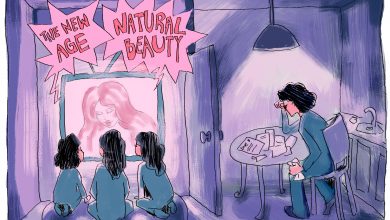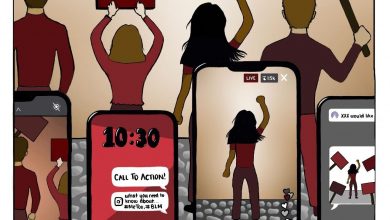You Are Not Colorblind

Illustration by Katherene Quiteno.
“I don’t see race. I’m colorblind.”
We’ve all heard it before. Colorblindness and its various incarnations seem to be a favorite claim among white people. According to them, we live in some sort of post-racial utopia where the only perpetrators of racism are bigots and if we all could just get along, everything would be peachy.
But what these people don’t seem to realize is that their claim is ignorant and dangerous, and when they use it they are being just as racist as the people they’re trying to distance themselves from. There are so many reasons why claiming colorblindness is racist, but here are the most important ones.
1. It’s avoiding the conversation
Some white people seem to think that talking about race automatically accuses all white people of racism. But by claiming colorblindness, they are shifting the conversation away from the injustices that people of color face and toward their own actions as self-proclaimed allies, as if the topic of the conversation should be about how great they are for supporting minorities.
This is exactly what’s happening when some white people insist on saying “all lives matter” instead of “black lives matter.” They are effectively ignoring the centuries-long history of black oppression which has fostered the stereotypes and prejudices that cause police officers to target African Americans. They are ignoring African Americans who are saying that the police are disproportionately murdering them and they are shifting the conversation away from the problem. This is yet another version of colorblindness, pretending that everyone is the same and ignoring the fact that our differences determine who the police give the benefit of the doubt.
No one cares that some white people in San Francisco or Portland have a couple black friends. Nothing is going to change if the conversation is always about how great white people are. That’s not how anything has ever changed. While ultimately those in power can write the laws, it’s those with no power who demand change. Progress happens when we highlight injustices and strive to fix them as much as we can.
2. It silences POC
Not only does claiming colorblindness avoid the conversation, it tries to prevent the conversation from happening in the first place.
White people in the US simply have not experienced racism on the scale of African Americans, Latinxs, Asian Americans, Native Americans, or other communities of color. It’s true that certain white ethnicities have faced discrimination in the past. But while shopkeepers put up “no Irish need apply” signs in their windows, mobs lynched African Americans. While German Americans were bullied and ostracized in the 1940s, Japanese Americans were rounded up like cattle and imprisoned. While some white ethnicities faced racism after immigrating here, it was Chinese immigrants who were banned by law, and it is immigrants from Central America who face mass deportation. Today, white ethnicities who faced discrimination have largely gotten over it, while people of color are still feeling the effects of centuries of racism. Generally, white people have had a pretty cushy life in America.
So when people of color talk about the racism they have experienced, white people can’t always be expected to understand. But that’s exactly why the conversation needs to be about the injustices toward people of color, and why people of color need to be the ones talking.
Sometimes white people need to just sit down and let someone else speak, and they have to trust that people of color know what they are talking about.
3. It blames the victim
There is a version of the colorblind claim that comes back around every year during Black History Month: “Don’t talk about race. It’s divisive.”
Though segregation is no longer legal, we still live in a segregated society. Within cities, there are often clear lines between racial communities. Generations of racial oppression have ensured that people of color take low-paying jobs, so poorer neighborhoods are often entirely black or brown. Zoning laws and loan interest rates further segregate cities, making it harder for people of color to live in cleaner, safer neighborhoods that are historically white and middle-class. Even in poorer, rural communities, towns are often monochromatic.
There is already division between races. They are divided because of generations of segregation enforced by those in power—white men. Telling people of color that talking about race is divisive is like telling women that the way they dress tempts rapists. It takes the blame off the oppressors and puts it on the victims of oppression.
4. Race influences everything
People who claim colorblindness are putting everyone on equal footing, as if it’s the racists that are oppressing people of color, not the system.
But that’s just not how it works. Even if tomorrow racism miraculously stopped existing, centuries of racial oppression have made it harder for people of color to graduate from high school, get into college, get hired, and buy homes.
Not all white people are (blatantly) racist, but all white people benefit from racism. People of color have been experiencing racism in America since the first European ship landed here. From slavery to Jim Crow, exclusive immigration laws to police brutality, the system has always been geared against those who are not white.
That’s one of the reasons why slavery reparations have come back into the news for the 2016 election. Between 1790 and 1860, African Americans lost an estimated $59.2 trillion (adjusted for inflation) while they were enslaved. African Americans began their post-slavery lives in the US already at a significant disadvantage. Today, African American families are more likely to live below the poverty line.
It’s not just African Americans either. One in four Native Americans lives in poverty. Out of the 5.2 million Native Americans in the United States, 22 percent live on reservations where the living conditions are “comparable to the Third World.” One in four Latinx Americans also lives in poverty, with many relegated to farm labor where there is little room for upward mobility. Though Asian Americans are often called the “model minority” (a racist and ignorant term in itself), the majority of Asian ethnicities in the United States have a higher poverty rate than whites and make up 12 percent of undocumented immigrants. We do not all start in the same place, and race has a lot to do with it.
Ignoring race discounts the centuries of oppression that contribute significantly to racial inequality today. While the individual white people claiming they don’t “see” color may not be overtly racist themselves, they benefit from a racist system.
Everyone is not the same, and our differences should be celebrated, not ignored.




